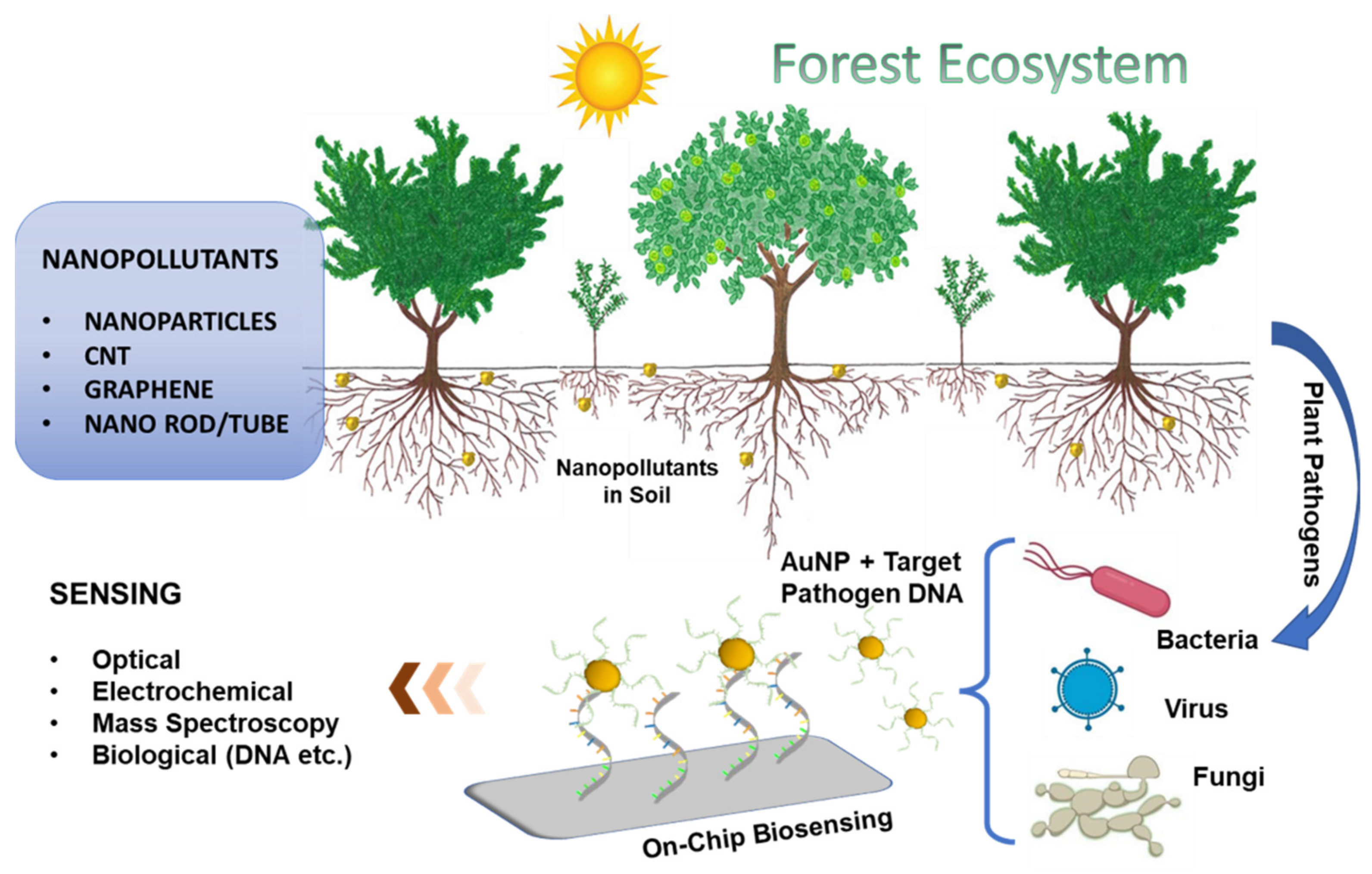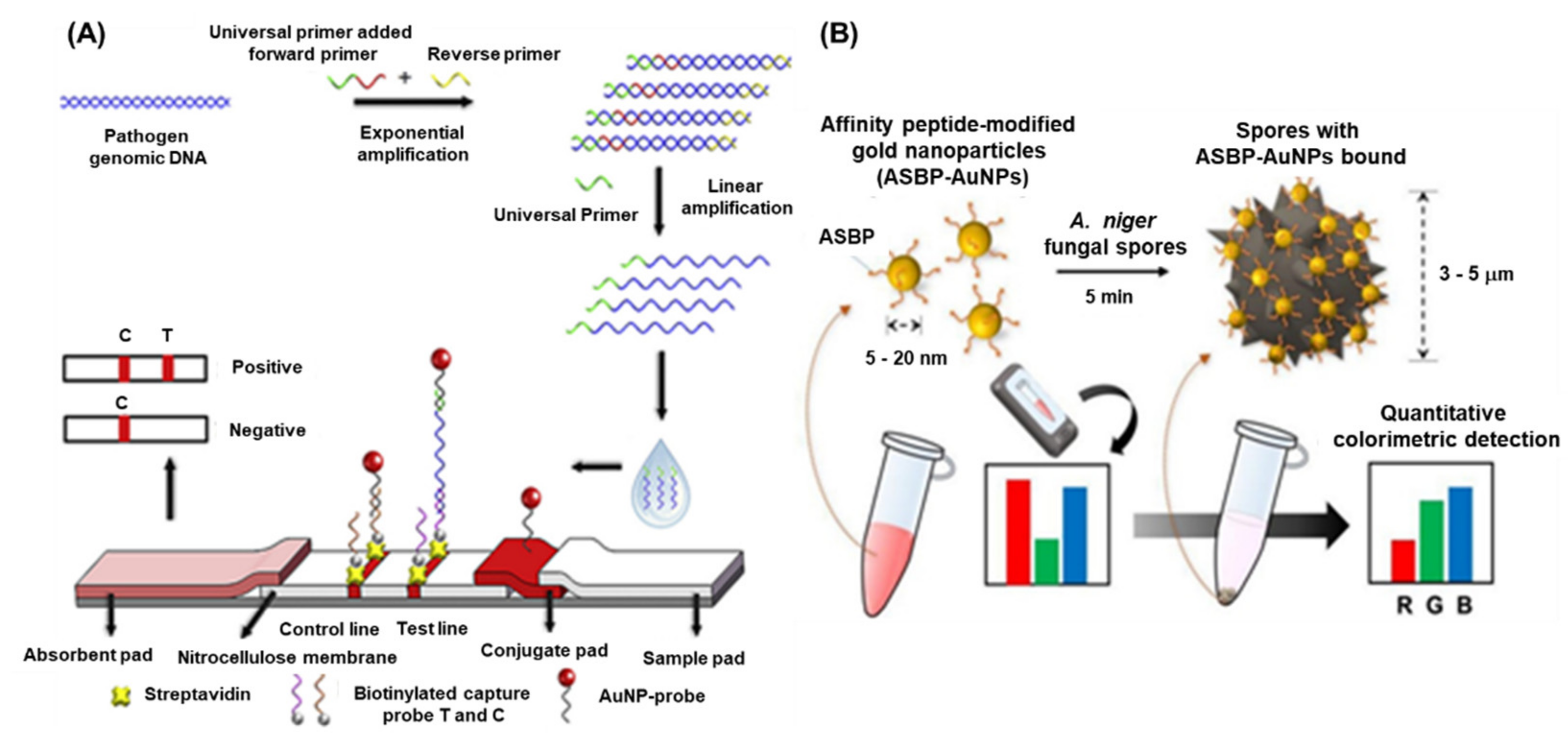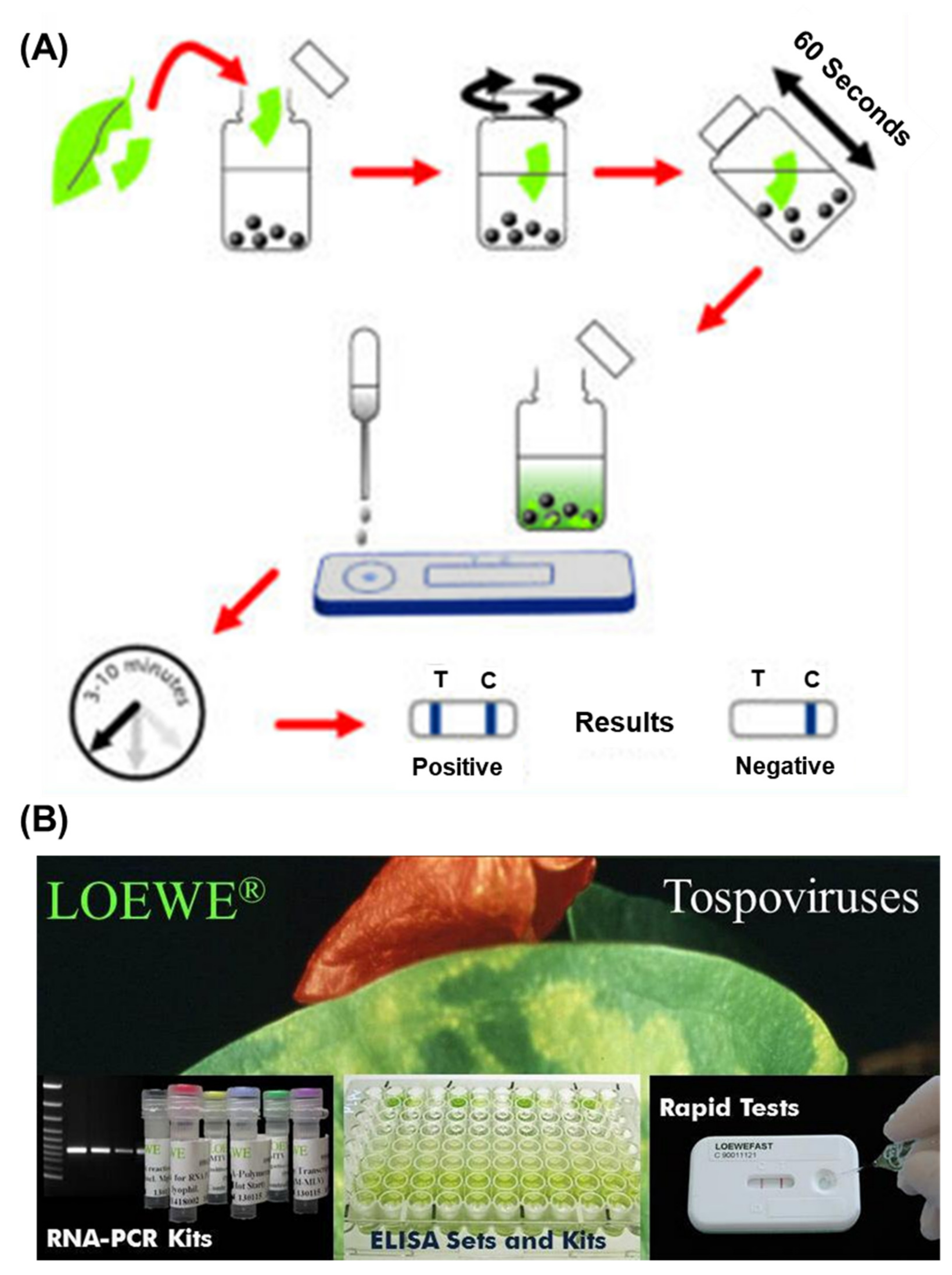Gold Nanoparticles and Plant Pathogens: An Overview and Prospective for Biosensing in Forestry
Abstract
:1. Introduction
2. Plant Pathogens and Plant Diseases
3. Gold Nanoparticle Based Biosensors
3.1. Electrochemical Biosensors
3.2. Enzyme Biosensors
3.3. Immunosensors
3.4. DNA Sensors
4. Pathogen Biosensing
4.1. Bacterial Pathogen Detection
4.2. Detection of Fungal Pathogens
4.3. Detection of Viruses
5. Prospects and Possibilities in Forestry
Author Contributions
Funding
Institutional Review Board Statement
Informed Consent Statement
Data Availability Statement
Acknowledgments
Conflicts of Interest
References
- Husen, A.; Jawaid, M. (Eds.) Nanomaterials for Agriculture and Forestry Applications; Elsevier: Amsterdam, The Netherlands, 2020; ISBN 9780128178522. [Google Scholar]
- Pingarrón, J.M.; Yáñez-Sedeño, P.; González-Cortés, A. Gold nanoparticle-based electrochemical biosensors. Electrochim. Acta 2008, 53, 5848–5866. [Google Scholar] [CrossRef]
- Aldewachi, H.; Chalati, T.; Woodroofe, M.N.; Bricklebank, N.; Sharrack, B.; Gardiner, P. Gold nanoparticle-based colorimetric biosensors. Nanoscale 2017, 10, 18–33. [Google Scholar] [CrossRef] [PubMed] [Green Version]
- Guo, X. Surface plasmon resonance based biosensor technique: A review. J. Biophotonics 2012, 5, 483–501. [Google Scholar] [CrossRef] [PubMed]
- Holzinger, M.; Le Goff, A.; Cosnier, S. Nanomaterials for biosensing applications: A review. Front. Chem. 2014, 2, 63. [Google Scholar] [CrossRef] [Green Version]
- Elmer, W.; White, J.C. The future of nanotechnology in plant pathology. Annu. Rev. Phytopathol. 2018, 56, 111–133. [Google Scholar] [CrossRef]
- Fang, Y.; Ramasamy, R.P. Current and prospective methods for plant disease detection. Biosensors 2015, 5, 537–561. [Google Scholar] [CrossRef] [Green Version]
- Albrecht, A.; Kandji, S.T. Carbon sequestration in tropical agroforestry systems. Agric. Ecosyst. Environ. 2003, 99, 15–27. [Google Scholar] [CrossRef]
- Bonan, G.B. Forests and climate change: Forcings, feedbacks, and the climate benefits of forests. Science 2008, 320, 1444–1449. [Google Scholar] [CrossRef] [Green Version]
- Zomer, R.J.; Neufeldt, H.; Xu, J.; Ahrends, A.; Bossio, D.; Trabucco, A.; Van Noordwijk, M.; Wang, M. Global Tree Cover and Biomass Carbon on Agricultural Land: The contribution of agroforestry to global and national carbon budgets. Sci. Rep. 2016, 6, 29987. [Google Scholar] [CrossRef] [Green Version]
- Boyd, I.L.; Freer-Smith, P.H.; Gilligan, C.A.; Godfray, H.C.J. The consequence of tree pests and diseases for ecosystem services. Science 2013, 342, 1235773. [Google Scholar] [CrossRef]
- Berger, S.; Sinha, A.K.; Roitsch, T. Plant physiology meets phytopathology: Plant primary metabolism and plant–pathogen interactions. J. Exp. Bot. 2007, 58, 4019–4026. [Google Scholar] [CrossRef] [PubMed]
- Boa, E. An Illustrated Guide to The State of Health of Trees: Recognition and Interpretation of Symptoms and Damage; FAO: Rome, Italy, 2003. [Google Scholar]
- Lau, H.Y.; Wu, H.; Wee, E.J.H.; Trau, M.; Wang, Y.; Botella, J.R. Specific and Sensitive Isothermal Electrochemical Biosensor for Plant Pathogen DNA Detection with Colloidal Gold Nanoparticles as Probes. Sci. Rep. 2017, 7, 38896. [Google Scholar] [CrossRef]
- Razmi, A.; Golestanipour, A.; Nikkhah, M.; Bagheri, A.; Shamsbakhsh, M.; Malekzadeh-Shafaroudi, S. Localized surface plasmon resonance biosensing of tomato yellow leaf curl virus. J. Virol. Methods 2019, 267, 1–7. [Google Scholar] [CrossRef] [PubMed]
- Malhotra, B.D.; Ali, M.A. Nanomaterials in Biosensors: Fundamentals and Applications. Nanomater. Biosens. 2018, 37, 1–74. [Google Scholar] [CrossRef]
- Parthasarathy, S.; Thiribhuvanamala, G.; Muthulakshmi, P.; Angappan, K. Diseases of Forest Trees and their Management; CRC Press: Boca Raton, FL, USA, 2021; ISBN 9781003173861. [Google Scholar]
- Manion, P.D. Tree Disease Concepts; Prentice Hall: Englewood Cliffs, NJ, USA, 1991; ISBN 9780139294235. [Google Scholar]
- Kainthola, C.; Harsh, N.S.K.; Ginwal, H.S.; Tripathi, A.; Saha, R.; Pandey, A. New Report of Fusarium flocciferum Causing Rot of Emerging Culm in Dendrocalamus strictus. Indian For. 2022, 147, 1220–1225. [Google Scholar]
- Biju, V. Chemical modifications and bioconjugate reactions of nanomaterials for sensing, imaging, drug delivery and therapy. Chem. Soc. Rev. 2014, 43, 744–764. [Google Scholar] [CrossRef]
- Turkevich, B.J.; Stevenson, P.C.; Hillier, J. A Study of the Nucleation and Growth Processes in the Synthesis of Colloidal Gold. Anal. Chem. 1941, 47, 475. [Google Scholar] [CrossRef]
- Yuan, Y.; Wang, Y.; Wang, H.; Hou, S. Gold nanoparticles decorated on single layer graphene applied for electrochemical ultrasensitive glucose biosensor. J. Electroanal. Chem. 2019, 855, 113495. [Google Scholar] [CrossRef]
- Ebrahimi, M.; Norouzi, P.; Safarnejad, M.R.; Tabaei, O.; Haji-Hashemi, H. Fabrication of a label-free electrochemical immunosensor for direct detection of Candidatus Phytoplasma Aurantifolia. J. Electroanal. Chem. 2019, 851, 113451. [Google Scholar] [CrossRef]
- Ozsoz, M.; Erdem, A.; Kerman, K.; Ozkan, D.; Tugrul, B.; Topcuoglu, N.; Ekren, H.; Taylan, M. Electrochemical genosensor based on colloidal gold nanoparticles for the detection of Factor V Leiden mutation using disposable pencil graphite electrodes. Anal. Chem. 2003, 75, 2181–2187. [Google Scholar] [CrossRef]
- Wang, Y.; Alocilja, E.C. Gold nanoparticle-labeled biosensor for rapid and sensitive detection of bacterial pathogens. J. Biol. Eng. 2015, 9, 16. [Google Scholar] [CrossRef] [PubMed] [Green Version]
- Rochelet-Dequaire, M.; Limoges, B.; Brossier, P. Subfemtomolar electrochemical detection of target DNA by catalytic enlargement of the hybridized gold nanoparticle labels. Analyst 2006, 131, 923–929. [Google Scholar] [CrossRef] [PubMed] [Green Version]
- Kerman, K.; Morita, Y.; Takamura, Y.; Ozsoz, M.; Tamiya, E. Modification of Escherichia coli single-stranded DNA binding protein with gold nanoparticles for electrochemical detection of DNA hybridization. Anal. Chim. Acta 2004, 510, 169–174. [Google Scholar] [CrossRef]
- Lipińska, W.; Grochowska, K.; Siuzdak, K. Enzyme Immobilization on Gold Nanoparticles for Electrochemical Glucose Biosensors. Nanomaterials 2021, 11, 1156. [Google Scholar] [CrossRef] [PubMed]
- Liu, G.; Lin, Y. Nanomaterial Labels in Electrochemical Immunosensors and Immunoassays. Talanta 2007, 74, 308–317. [Google Scholar] [CrossRef] [PubMed] [Green Version]
- Omidfar, K.; Zarei, H.; Gholizadeh, F.; Larijani, B. A high-sensitivity electrochemical immunosensor based on mobile crystalline material-41-polyvinyl alcohol nanocomposite and colloidal gold nanoparticles. Anal. Biochem. 2012, 421, 649–656. [Google Scholar] [CrossRef]
- Cai, H.; Xu, C.; He, P.; Fang, Y. Colloid Au-enhanced DNA immobilization for the electrochemical detection of sequence-specific DNA. J. Electroanal. Chem. 2001, 510, 78–85. [Google Scholar] [CrossRef]
- Zhao, W.; Lu, J.; Ma, W.; Xu, C.; Kuang, H.; Zhu, S. Rapid on-site detection of Acidovorax avenae subsp. citrulli by gold-labeled DNA strip sensor. Biosens. Bioelectron. 2011, 26, 4241–4244. [Google Scholar] [CrossRef]
- Vaseghi, A.; Safaie, N.; Bakhshinejad, B.; Mohsenifar, A.; Sadeghizadeh, M. Detection of Pseudomonas syringae pathovars by thiol-linked DNA–Gold nanoparticle probes. Sens. Actuators B Chem. 2013, 181, 644–651. [Google Scholar] [CrossRef]
- Khaledian, S.; Nikkhah, M.; Shams-bakhsh, M.; Hoseinzadeh, S. A sensitive biosensor based on gold nanoparticles to detect Ralstonia solanacearum in soil. J. Gen. Plant Pathol. 2017, 83, 231–239. [Google Scholar] [CrossRef]
- Zhao, Y.; Liu, L.; Kong, D.; Kuang, H.; Wang, L.; Xu, C. Dual Amplified Electrochemical Immunosensor for Highly Sensitive Detection of Pantoea stewartii sbusp. stewartii. ACS Appl. Mater. Interfaces 2014, 6, 21178–21183. [Google Scholar] [CrossRef] [PubMed]
- Byzova, N.; Vinogradova, S.; Porotikova, E.; Terekhova, U.; Zherdev, A.; Dzantiev, B. Lateral Flow Immunoassay for Rapid Detection of Grapevine Leafroll-Associated Virus. Biosensors 2018, 8, 111. [Google Scholar] [CrossRef] [PubMed] [Green Version]
- Lau, H.Y.; Wang, Y.; Wee, E.J.H.; Botella, J.R.; Trau, M. Field Demonstration of a Multiplexed Point-of-Care Diagnostic Platform for Plant Pathogens. Anal. Chem. 2016, 88, 8074–8081. [Google Scholar] [CrossRef] [PubMed]
- Ariffin, S.A.B.; Adam, T.; Hashim, U.; Sfaridah, S.F.; Zamri, I.; Uda, M.N.A. Plant Diseases Detection Using Nanowire as Biosensor Transducer. Adv. Mater. Res. 2014, 832, 113–117. [Google Scholar] [CrossRef]
- Detection of Candidatus Phytoplasma Aurantifolia with a Quantum Dots Fret-Based Biosensor on Jstor. Available online: https://www.jstor.org/stable/45156279 (accessed on 26 October 2021).
- Jian, Y.-S.; Lee, C.-H.; Jan, F.-J.; Wang, G.-J. Detection of Odontoglossum Ringspot Virus Infected Phalaenopsis Using a Nano-Structured Biosensor. J. Electrochem. Soc. 2018, 165, H449. [Google Scholar] [CrossRef]
- Yao, K.S.; Li, S.J.; Tzeng, K.C.; Cheng, T.C.; Chang, C.Y.; Chiu, C.Y.; Liao, C.Y.; Hsu, J.J.; Lin, Z.P. Fluorescence Silica Nanoprobe as a Biomarker for Rapid Detection of Plant Pathogens. Adv. Mater. Res. 2009, 79–82, 513–516. [Google Scholar] [CrossRef]
- Razo, S.C.; Panferova, N.A.; Panferov, V.G.; Safenkova, I.V.; Drenova, N.V.; Varitsev, Y.A.; Zherdev, A.V.; Pakina, E.N.; Dzantiev, B.B. Enlargement of Gold Nanoparticles for Sensitive Immunochromatographic Diagnostics of Potato Brown Rot. Sensors 2019, 19, 153. [Google Scholar] [CrossRef] [PubMed] [Green Version]
- Singh, S.; Singh, M.; Agrawal, V.V.; Kumar, A. An attempt to develop surface plasmon resonance based immunosensor for Karnal bunt (Tilletia indica) diagnosis based on the experience of nano-gold based lateral flow immuno-dipstick test. Thin Solid Films 2010, 519, 1156–1159. [Google Scholar] [CrossRef] [Green Version]
- Choi, O.; Deng, K.K.; Kim, N.J.; Ross, L.; Surampalli, R.Y.; Hu, Z. The inhibitory effects of silver nanoparticles, silver ions, and silver chloride colloids on microbial growth. Water Res. 2008, 42, 3066–3074. [Google Scholar] [CrossRef]
- Luna-Moreno, D.; Sánchez-Álvarez, A.; Islas-Flores, I.; Canto-Canche, B.; Carrillo-Pech, M.; Villarreal-Chiu, J.F.; Rodríguez-Delgado, M. Early Detection of the Fungal Banana Black Sigatoka Pathogen Pseudocercospora fijiensis by an SPR Immunosensor Method. Sensors 2019, 19, 465. [Google Scholar] [CrossRef] [Green Version]
- Zhan, F.; Wang, T.; Iradukunda, L.; Zhan, J. A gold nanoparticle-based lateral flow biosensor for sensitive visual detection of the potato late blight pathogen, Phytophthora infestans. Anal. Chim. Acta 2018, 1036, 153–161. [Google Scholar] [CrossRef] [PubMed]
- Fisher, M.C.; Gurr, S.J.; Cuomo, C.A.; Blehert, D.S.; Jin, H.; Stukenbrock, E.H.; Stajich, J.E.; Kahmann, R.; Boone, C.; Denning, D.W.; et al. Threats Posed by the Fungal Kingdom to Humans, Wildlife, and Agriculture. MBio 2020, 11, e00449-20. [Google Scholar] [CrossRef] [PubMed]
- Hariharan, G.; Prasannath, K. Recent Advances in Molecular Diagnostics of Fungal Plant Pathogens: A Mini Review. Front. Cell. Infect. Microbiol. 2021, 10, 829. [Google Scholar] [CrossRef] [PubMed]
- Iqbal, Z.; Khan, M.A.; Sharif, M.; Shah, J.H.; ur Rehman, M.H.; Javed, K. An automated detection and classification of citrus plant diseases using image processing techniques: A review. Comput. Electron. Agric. 2018, 153, 12–32. [Google Scholar] [CrossRef]
- Lei, R.; Wu, P.; Li, L.; Huang, Q.; Wang, J.; Zhang, D.; Li, M.; Chen, N.; Wang, X. Ultrasensitive isothermal detection of a plant pathogen by using a gold nanoparticle-enhanced microcantilever sensor. Sens. Actuators B Chem. 2021, 338, 129874. [Google Scholar] [CrossRef]
- Lee, J.I.; Jang, S.C.; Chung, J.; Choi, W.K.; Hong, C.; Ahn, G.R.; Kim, S.H.; Lee, B.Y.; Chung, W.J. Colorimetric allergenic fungal spore detection using peptide-modified gold nanoparticles. Sens. Actuators B Chem. 2021, 327, 128894. [Google Scholar] [CrossRef]
- Wang, L.; Liu, Z.; Xia, X.; Yang, C.; Huang, J.; Wan, S. Colorimetric detection of Cucumber green mottle mosaic virus using unmodified gold nanoparticles as colorimetric probes. J. Virol. Methods 2017, 243, 113–119. [Google Scholar] [CrossRef]
- Lavanya, R.; Arun, V. Detection of Begomovirus in chilli and tomato plants using functionalized gold nanoparticles. Sci. Rep. 2021, 11, 14203. [Google Scholar] [CrossRef]
- Das, S.; Agarwal, D.K.; Mandal, B.; Rao, V.R.; Kundu, T. Detection of the Chilli Leaf Curl Virus Using an Attenuated Total Reflection-Mediated Localized Surface-Plasmon-Resonance-Based Optical Platform. ACS Omega 2021, 6, 17413–17423. [Google Scholar] [CrossRef]
- Majumder, S.; Johari, S. Development of a gold-nano particle based novel dot immunobinding assay for rapid and sensitive detection of Banana bunchy top virus. J. Virol. Methods 2018, 255, 23–28. [Google Scholar] [CrossRef]
- Razo, S.C.; Panferov, V.G.; Safenkova, I.V.; Varitsev, Y.A.; Zherdev, A.V.; Dzantiev, B.B. Double-enhanced lateral flow immunoassay for potato virus X based on a combination of magnetic and gold nanoparticles. Anal. Chim. Acta 2018, 1007, 50–60. [Google Scholar] [CrossRef] [PubMed]
- Wang, L.; Shan, J.; Feng, F.; Ma, Z. Novel redox species polyaniline derivative-Au/Pt as sensing platform for label-free electrochemical immunoassay of carbohydrate antigen 199. Anal. Chim. Acta 2016, 911, 108–113. [Google Scholar] [CrossRef] [PubMed]
- Bhardwaj, J.; Devarakonda, S.; Kumar, S.; Jang, J. Development of a paper-based electrochemical immunosensor using an antibody-single walled carbon nanotubes bio-conjugate modified electrode for label-free detection of foodborne pathogens. Sens. Actuators B Chem. 2017, 253, 115–123. [Google Scholar] [CrossRef]
- Khater, M.; de la Escosura-Muñiz, A.; Quesada-González, D.; Merkoçi, A. Electrochemical detection of plant virus using gold nanoparticle-modified electrodes. Anal. Chim. Acta 2019, 1046, 123–131. [Google Scholar] [CrossRef] [Green Version]
- Wang, Y.; Li, B.; Liu, J.; Zhou, H. T4 DNA polymerase-assisted upgrade of a nicking/polymerization amplification strategy for ultrasensitive electrochemical detection of Watermelon mosaic virus. Anal. Bioanal. Chem. 2019, 411, 2915–2924. [Google Scholar] [CrossRef]
- Sloan, S.; Sayer, J.A. Forest Resources Assessment of 2015 shows positive global trends but forest loss and degradation persist in poor tropical countries. For. Ecol. Manag. 2015, 352, 134–145. [Google Scholar] [CrossRef] [Green Version]





| Sl. No. | Disease Name | Pathogen | Area and Timeline | Host |
|---|---|---|---|---|
| 1 | Dutch Elm Disease | Ophiostoma-novo-ulmi (Fungus) | Northwest Europe, 1910s | Ulmus sp. |
| 2 | Chestnut Blight | Cryphonectriaparasitica (Fungus) | USA, Canada, and Asia, 1904 | Castanea sativa |
| 3 | Beech Bark Disease | Cryptococcus fagisuga and Nectria Fungus (Insect Fungal Complex) | Northern America, 1920–1930s | Fagus grandifolia |
| 4 | Butternut Canker | Sirococcus sp. (Fungus) | North America and Eastern Canada | Juglans cinerea |
| 5 | Sudden Oak Death | Phytophthora ramorum (Fungus) | Oregon, California, and Europe | Oak sp. |
| 6 | White Pine Blister Rust | Cronarticumribicola (Fungus) | Baltic, Russia, 1854 | Pinus parviflora |
| 7 | Jarrah Dieback | Phytophthora cinnamomi (Fungus) | Sumatra, Indonesia, 1922 | Eucalyptus marginata |
| 8 | Fire Blight of Pome | Erwinia amylovora (Bacterium) | New York, 1780 | Pea, apple, and Rosaceous spp. |
| 9 | Pine Wilt | Bursaphelenchusxylophilus (Pine Wood Nematode) spread by Monochamus spp. Beetle (Pine Sawyer Beetle) | North America, East Asia, 1940s | Pine spp. |
| 10 | Scleroderris Canker | Gremmeniellaabietina | Canada, 1980s | Coniferous forests |
| 11 | Shisham Mortality
|
|
| Dalbergia sissoo |
| 12 | Sandal Spike Disease | Phytoplasma | Southern India, 1903 | Santalum album |
| No | Plant Disease/Pathogen | Species | Nanomaterial Used | Sensing Method | LOD | Ref. |
|---|---|---|---|---|---|---|
| 1 | Tomato Yellow Leaf Curl Virus (TYLCV) | Tomato | AuNps with colorimetric nano-biosensing | Localized surface plasmon resonance | 5 ng | [15] |
| 2 | Cucumber Mosaic Virus (CMV) and Papaya Ring Spot Virus (PRSV) | Papaya | Nanowire based biosensor | Amperometry detection | 0.1 mA/mL | [38] |
| 3 | Witches’ Broom Disease (Candidatus Phytoplasma aurantifolia) | Lime | Quantum dot (QD)-based nano-biosensor | Fluorescence resonance energy transfer (FRET) | 5 ca. P. aurantifolia/μL | [39] |
| 4 | Odontoglossum Ringspot Virus (ORSV) | Orchid leaves | anodic aluminum oxide (AAO) with AuNPs | Self-assembled monolayer (SAM) | 0.345 ng/mL | [40] |
| 5 | Bacterial Spot Disease by Xanthomonas axonopodis | Solanaceae plant | Fluorescence silica nanoparticles | Fluorescence-linked immunosorbent assay | NA | [41] |
| 6 | Ralstonia solanacearum (Potato Brown Rot) | Potato | Enlarging AuNPs | Lateral flow immunoassay | 3 × 104 cells/mL | [42] |
| 7 | Karnal Bunt Disease | Wheat | AuNPs | Surface Plasmone Resonance (SPR) | NA | [43] |
| 8 | Powdery Mildew | Rose | Colloidal nanosilver (1.5 nm diameter) | Relative fluorescence units | 4.2 μM Ag ions | [44] |
| 9 | Pseudocerocospora fijiensis Black Sigatoka (Leave Streak Disease) | Banana plants | cell wall protein HF1 of P. Fijiensis immobilized onto gold chip | Surface plasmon resonance based immunosensor | 11.7 μg/mL, | [45] |
| 10 | Late Blight in Potatoes and Tomatoes (caused by Phytophthora Infestans) | Potatoes and Tomatoes | AuNPs | PCR with AuNPs based lateral flow biosensor | 0.1 pg/mL range. | [46] |
| 11. | Acidovorax avenae subsp. citrulli | Fruits | Colloidal gold nanoparticles | Dipstick method | 0.48 nM of DNA | [32] |
Publisher’s Note: MDPI stays neutral with regard to jurisdictional claims in published maps and institutional affiliations. |
© 2022 by the authors. Licensee MDPI, Basel, Switzerland. This article is an open access article distributed under the terms and conditions of the Creative Commons Attribution (CC BY) license (https://creativecommons.org/licenses/by/4.0/).
Share and Cite
Kulabhusan, P.K.; Tripathi, A.; Kant, K. Gold Nanoparticles and Plant Pathogens: An Overview and Prospective for Biosensing in Forestry. Sensors 2022, 22, 1259. https://doi.org/10.3390/s22031259
Kulabhusan PK, Tripathi A, Kant K. Gold Nanoparticles and Plant Pathogens: An Overview and Prospective for Biosensing in Forestry. Sensors. 2022; 22(3):1259. https://doi.org/10.3390/s22031259
Chicago/Turabian StyleKulabhusan, Prabir Kumar, Anugrah Tripathi, and Krishna Kant. 2022. "Gold Nanoparticles and Plant Pathogens: An Overview and Prospective for Biosensing in Forestry" Sensors 22, no. 3: 1259. https://doi.org/10.3390/s22031259
APA StyleKulabhusan, P. K., Tripathi, A., & Kant, K. (2022). Gold Nanoparticles and Plant Pathogens: An Overview and Prospective for Biosensing in Forestry. Sensors, 22(3), 1259. https://doi.org/10.3390/s22031259







